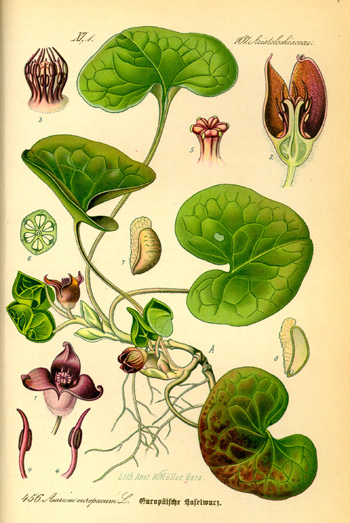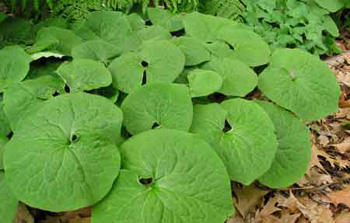Contents:
Common Names | Parts Usually Used | Plant(s) & Culture | Where Found | Medicinal Properties
Uses | Formulas or Dosages | Warning | Bibliography
Scientific Names

- Asarum Europaeum
- Aristoloch
- Asarum canadense L.
- Aristolochiaceae
Common Names
Asarum Europaeum:
- Asarabacca
- European snakeroot
- Hazelwort
- Public house plant
- Wild nard
Asarum canadense L.:
- Canada snake root
- Indian ginger
- Vermont snake root
- Wild Canada ginger
- Wild ginger
Parts Usually Used
Asarum Europaeum – Rootstock, leaves
Asarum canadense L. – Root
Back to Top

Description of Plant(s) and Culture
Asarum Europaeum
Asarum is a perennial, evergreen plant; a low plant with a horizontal, creeping rootstock and prostrate stem. Two long-petioled, upright, shiny, leathery, dark green leaves grow from each bud on the stem, rising from 2-4 inches above the ground. The large, solitary flowers appear from March to May and are characterized by a green-brown color on the outside, reddish-black on the inside.
Asarum canadense L.
Asarum canadense is a perennial plant; the knobby, root of the plant is round and fleshy, with dividing stem supporting a heart-shaped, deep green above and a light green below, soft, woolly and handsomely veined leaf, there being two to a plant. A single flower is small and brownish-purple, growing only a few inches high and covered by the dead leaves that carpet the woods. The taste is pungent and bitter.
Back to Top
Where Found
Asarum Europaeum Grows in European woods
Asarum canadense L. Grows in rich woods from Maine to Michigan,
and southward.
Back to Top
Medicinal Properties
Asarum Europaeum – Rootstock: diuretic, emetic, purgative Leaves: cathartic, emetic, errhine
Asarum canadense L. – Stimulant, carminative, tonic, diaphoretic, diuretic
Back to Top
Uses
Asarum Europaeum – Basic use is emetic. It is mixed with lance-leaf plantain to stop mucus congestion in the nose and respiratory passages. Asarum is too dangerous to be used without medical supervision.
Asarum canadense L. – Used as an appetite stimulant. Externally, used to ease the pains of gout, remove freckles, as a poultice for snakebite, colds, whooping cough, headache, dysmenorrhea, hysteria, typhus, alcoholism, dropsy, ague, and fevers. Used by Native Americans as a ginger substitute for its flavor.
Back to Top
Formulas or Dosages
Do not boil this herb; boiling weakens its properties.
Back to Top
Warning
Asarum Europaeum – Asarum is too dangerous to be used without medical supervision.
Asarum canadense L. – Large doses cause nausea, vomiting, and diarrhea. Use under medical supervision.
Back to Top
Bibliography
![]() The Herb Book
The Herb Book, by John Lust, Bantam Books, 666 Fifth Avenue, New York, NY. copyright 1974.
![]() Eastern/Central Medicinal Plants
Eastern/Central Medicinal Plants, by Steven Foster and James A. Duke., Houghton Mifflin Company, 215 Park Avenue South, New York, NY 10000
![]() Culpeper’s Complete Herbal & English Physician: Updated With 117 Modern Herbs
Culpeper’s Complete Herbal & English Physician: Updated With 117 Modern Herbs, by Nicholas Culpeper, Meyerbooks, publisher, PO Box 427, Glenwood, Illinois 60425, 1990, (reprint of 1814)
Herbal Gardening, compiled by The Robison York State Herb Garden, Cornell Plantations, Matthaei Botanical Gardens of the University of Michigan, University of California Botanical Garden, Berkeley., Pantheon Books, Knopf Publishing Group, New York, 1994, first edition
![]() Indian Herbalogy of North America
Indian Herbalogy of North America, by Alma R. Hutchens, Shambala Publications, Inc., Horticultural Hall, 300 Massachusetts Avenue, Boston, Massachusetts 02115, 1973
![]() Planetary Herbology
Planetary Herbology, by Michael Tierra, C.A., N.D., O.M.D., Lotus Press, PO Box 325, Twin Lakes. WI 53181., Copyright 1988, published 1992
![]() Webster’s New World Dictionary
Webster’s New World Dictionary, Third College Edition, Victoria Neufeldt, Editor in Chief, New World Dictionaries: A Division of Simon & Schuster, Inc., 15 Columbus Circle, New York, NY 10023
 The Rodale Herb Book: How to Use, Grow, and Buy Nature’s Miracle Plants (An Organic gardening and farming book)
The Rodale Herb Book: How to Use, Grow, and Buy Nature’s Miracle Plants (An Organic gardening and farming book), edited by William H. Hylton, Rodale Press, Inc. Emmaus, PA, 18049., 1974
